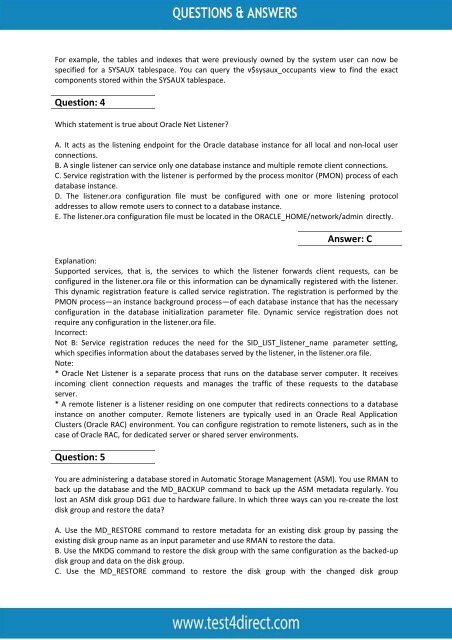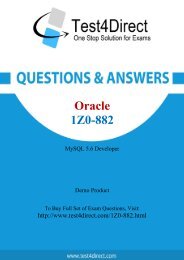1Z0-060 Real BrainDumps
Test4Direct provides latest PDF questions of Oracle 1Z0-060 exam. You have an opportunity to pass the Oracle 1Z0-060 exam in one go. Test4Direct is most accurate source to prepare Oracle 1Z0-060 exam as your success will become site’s responsibility after purchasing 1Z0-060 exam product. There are also lots of discounts and promotion offers that you can avail. Let’s try a free demo http://www.test4direct.com/1Z0-060.html
Test4Direct provides latest PDF questions of Oracle 1Z0-060 exam. You have an opportunity to pass the Oracle 1Z0-060 exam in one go. Test4Direct is most accurate source to prepare Oracle 1Z0-060 exam as your success will become site’s responsibility after purchasing 1Z0-060 exam product. There are also lots of discounts and promotion offers that you can avail. Let’s try a free demo http://www.test4direct.com/1Z0-060.html
You also want an ePaper? Increase the reach of your titles
YUMPU automatically turns print PDFs into web optimized ePapers that Google loves.
For example, the tables and indexes that were previously owned by the system user can now be<br />
specified for a SYSAUX tablespace. You can query the v$sysaux_occupants view to find the exact<br />
components stored within the SYSAUX tablespace.<br />
Question: 4<br />
Which statement is true about Oracle Net Listener?<br />
A. It acts as the listening endpoint for the Oracle database instance for all local and non-local user<br />
connections.<br />
B. A single listener can service only one database instance and multiple remote client connections.<br />
C. Service registration with the listener is performed by the process monitor (PMON) process of each<br />
database instance.<br />
D. The listener.ora configuration file must be configured with one or more listening protocol<br />
addresses to allow remote users to connect to a database instance.<br />
E. The listener.ora configuration file must be located in the ORACLE_HOME/network/admin directly.<br />
Question: 5<br />
Answer: C<br />
Explanation:<br />
Supported services, that is, the services to which the listener forwards client requests, can be<br />
configured in the listener.ora file or this information can be dynamically registered with the listener.<br />
This dynamic registration feature is called service registration. The registration is performed by the<br />
PMON process—an instance background process—of each database instance that has the necessary<br />
configuration in the database initialization parameter file. Dynamic service registration does not<br />
require any configuration in the listener.ora file.<br />
Incorrect:<br />
Not B: Service registration reduces the need for the SID_LIST_listener_name parameter setting,<br />
which specifies information about the databases served by the listener, in the listener.ora file.<br />
Note:<br />
* Oracle Net Listener is a separate process that runs on the database server computer. It receives<br />
incoming client connection requests and manages the traffic of these requests to the database<br />
server.<br />
* A remote listener is a listener residing on one computer that redirects connections to a database<br />
instance on another computer. Remote listeners are typically used in an Oracle <strong>Real</strong> Application<br />
Clusters (Oracle RAC) environment. You can configure registration to remote listeners, such as in the<br />
case of Oracle RAC, for dedicated server or shared server environments.<br />
You are administering a database stored in Automatic Storage Management (ASM). You use RMAN to<br />
back up the database and the MD_BACKUP command to back up the ASM metadata regularly. You<br />
lost an ASM disk group DG1 due to hardware failure. In which three ways can you re-create the lost<br />
disk group and restore the data?<br />
A. Use the MD_RESTORE command to restore metadata for an existing disk group by passing the<br />
existing disk group name as an input parameter and use RMAN to restore the data.<br />
B. Use the MKDG command to restore the disk group with the same configuration as the backed-up<br />
disk group and data on the disk group.<br />
C. Use the MD_RESTORE command to restore the disk group with the changed disk group


















